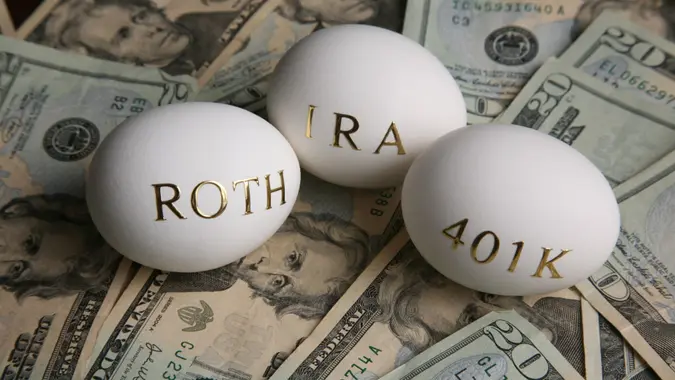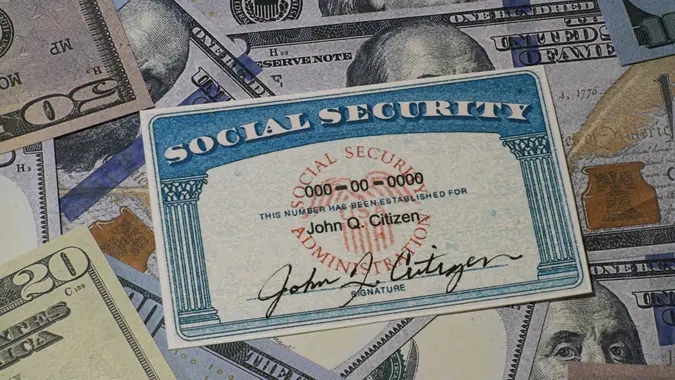50 With No Retirement Savings? Here’s Where To Start

Commitment to Our Readers
GOBankingRates' editorial team is committed to bringing you unbiased reviews and information. We use data-driven methodologies to evaluate financial products and services - our reviews and ratings are not influenced by advertisers. You can read more about our editorial guidelines and our products and services review methodology.

20 Years
Helping You Live Richer

Reviewed
by Experts

Trusted by
Millions of Readers
If you’re 50 or older and have zero retirement savings, you might feel a bit panicked. While this situation isn’t ideal, it’s definitely fixable.
Now is the time to roll up your sleeves and get to work. If you’re willing to make big changes, you can start putting serious money aside for your golden years.
GOBankingRates talked to two financial advisors to find out the steps you need to take to get started — here’s what they said.
Determine Your Cost of Living
The first step to start saving for retirement is to figure out your cost of living, said A.B. Ridgeway, MBA, enrolled agent (EA), certified private wealth advisor (CPWA), certified divorce financial analyst (CDFA), owner of A.B. Ridgeway Wealth Management. You’ll need to break your expenses down into two categories — discretionary and non-discretionary.
He said non-discretionary expenses are monthly bills you’re required to pay — such as mortgage, auto loans, utility bills, etcetera. On the other hand, discretionary expenses are monthly bills that might fluctuate — such as food, clothing, entertainment, etcetera.
“Now take your total net income and subtract your non-discretionary expenses and this is the amount you can work with to improve your savings,” he said.
Taking it a step further, he recommended dividing your discretionary expenses into wants and needs, so you can further trim your expenses.
Pay Down Debt
If you’re in debt, it’s time to create a repayment strategy, Ridgeway said
“Many may argue which is a better strategy for debt repayment — the avalanche technique, where you pay the highest interest rates first versus the snowball technique, where you pay the smallest balances first,” he said.
Since you’re trying to save the most money in the shortest amount of time, he advised opting for the avalanche method. He said this is the fastest approach to reducing your debt.
“The goal is to have the least amount of non-discretionary expenses as possible during retirement, which is directly related to your cost of living,” he said.
Automate Your Savings
After paying off at least some of your debt, it’s time to start saving. Aim to put aside approximately six to nine months of monthly expenses, plus an additional month or two for each dependent not contributing income, Ridgeway said.
This should be done to safeguard your finances against loss of employment, job transfers or unexpected emergencies, he said. These contributions should be automated, as it will eliminate the temptation to spend the money.
Maximize Tax-Advantaged Accounts
If you’re eligible to start contributing to a 401(k), 403(b) or similar employer-sponsored plan, then do so — especially if there’s a match, said Daniel Milks, certified financial planner (CFP), founder of Fiduciary Organization and Woodmark Advisors.
In 2025, individuals aged 50 and over can put up to $31,000 in most 401(k), 403(b), governmental 457 plans and the federal government’s Thrift Savings Plan — using catch-up contributions — according to the IRS. The catch-up contribution limit for an IRA is $8,000.
Consider Delaying Retirement
Retiring as soon as possible might sound ideal, but it’s probably not the best move financially. If you can swing it, staying it the workforce can quite literally pay off.
“Working a few extra years can dramatically improve your savings potential and increase your Social Security benefits — especially if you delay taking them until age 70,” Milks said.
Get Professional Guidance
“At this stage, small mistakes can have big consequences,” Milks said. “Partnering with a fiduciary financial advisor can help you create a tax-efficient, goal-focused plan that maximizes every dollar.”
Until this point, you might’ve handled your finances entirely on your own. However, seeking professional guidance could help ensure you get your retirement savings on track.
 Written by
Written by  Edited by
Edited by 


























